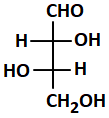Select Chapter Topics:
Lactose is a disaccharide composed of:
| 1. | \(\alpha - D-\)Glucose and \(\beta-D-\)Galactose |
| 2. | \(\beta-D-\)Glucose and \(\beta-D-\)Galactose |
| 3. | \(\beta - D-\)Glucose and \(\alpha-D-\)Galactose |
| 4. | \(\alpha - D-\)Glucose and \(\alpha-D-\)Galactose |
Subtopic: Polysaccharides & their Importance |
63%
Level 2: 60%+
Please attempt this question first.
Hints
Please attempt this question first.
Unlock IMPORTANT QUESTION
This question was bookmarked by 5 NEET 2025 toppers during their NEETprep journey. Get Target Batch to see this question.
✨ Perfect for quick revision & accuracy boost
Buy Target Batch
Access all premium questions instantly
| Assertion (A): | Deoxyribose, , is not a carbohydrate. |
| Reason (R): | Carbohydrates are hydrates of carbon so compounds that follow the formula are carbohydrates. |
| 1. | Both (A) and (R) are True and (R) is the correct explanation of (A). |
| 2. | Both (A) and (R) are False. |
| 3. | (A) is True but (R) is False. |
| 4. | (A) is False but (R) is True. |
Subtopic: Polysaccharides & their Importance |
Level 3: 35%-60%
Hints
Fructose reduces Tollen's reagent due to:
| 1. | Primary alcoholic group |
| 2. | Secondary alcoholic group |
| 3. | Enolisation of fructose followed by conversion to aldehyde by base |
| 4. | Asymmetric carbon |
Subtopic: Carbohydrates - Classification & D-L configuration |
72%
Level 2: 60%+
AIPMT - 2010
Hints
Monosaccharides are:
| 1. | Carbohydrates that can't be hydrolysed further to give simpler units of polyhydroxy aldehyde or ketone. |
| 2. | Classified on the basis of the number of carbon atoms and the functional group present in them. |
| 3. | The monomers of carbohydrates. |
| 4. | All of the above. |
Subtopic: Carbohydrates - Classification & D-L configuration |
85%
Level 1: 80%+
Hints
Glucose and Fructose can be distinguished by the use of :
1. Fehling solution
2. Tollen's reagent
3. Bromine water
4. All of the above
Subtopic: Carbohydrates - Classification & D-L configuration |
Level 3: 35%-60%
Please attempt this question first.
Hints
Please attempt this question first.
The reaction of concentrated sulphuric acid with carbohydrates (C12H22O11) is an example of:
1. Dehydration
2. Oxidation
3. Reduction
4. Sulphonation
Subtopic: Polysaccharides & their Importance |
62%
Level 2: 60%+
NEET - 2020
Hints
Consider the following statements:
The correct statements are:
1. (a) and (b) only
2. (b) and (c) only
3. (a) and (c) only
4. (a), (b) and (c)
| a. | Glucose is also known as dextrose. |
| b. | Glucose is oxidized to saccharic acid using bromine water. |
| c. | \(\alpha - \text D (+) -\) Glucose contains five chiral centers. |
The correct statements are:
1. (a) and (b) only
2. (b) and (c) only
3. (a) and (c) only
4. (a), (b) and (c)
Subtopic: Carbohydrates - Classification & D-L configuration |
59%
Level 3: 35%-60%
Please attempt this question first.
Hints
Please attempt this question first.
The major product obtained when glucose reacts with bromine water among the following is:
1. Gluconic acid
2. Glyceraldehyde
3. Sorbitol
4. Saccharic acid
Subtopic: Carbohydrates - Classification & D-L configuration |
83%
Level 1: 80%+
Please attempt this question first.
Hints
Please attempt this question first.
D-glucose upon treatment with nitric acid gives:
| 1. |  |
2. |  |
| 3. |  |
4. |  |
Subtopic: Carbohydrates - Classification & D-L configuration |
73%
Level 2: 60%+
Please attempt this question first.
Hints
Please attempt this question first.
Which one is not a D-sugar:
| 1. |  |
2. |  |
| 3. |  |
4. |  |
Subtopic: Carbohydrates - Classification & D-L configuration |
70%
Level 2: 60%+
NEET - 2022
Hints






